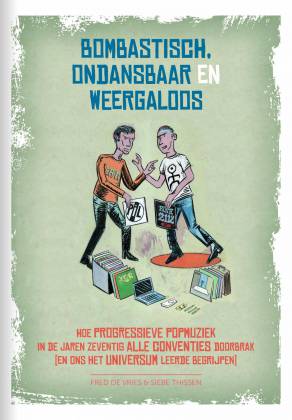

Bombastisch, ondansbaar en weergaloos
Hoe progressieve popmuziek in de jaren zeventig alle conventies doorbrak
Beschrijving
Met de doorbraak van Spotify en het gebruik van rocksongs in commercials en Netflix-series staat de geschiedenis van de popmuziek volop in de belangstelling – óók de bombastische en ondansbare progrock van de jaren 1970.
Fred de Vries en Siebe Thissen waren jonge muziekliefhebbers in de jaren 1970. Het was de tijd waarin popmuziek zichzelf serieus begon te nemen, een kunstvorm werd. Musici koketteerden met filosofen, schrijvers, kunstenaars en goeroes. Ze verzonnen groteske namen voor hun bands, maakten artistieke klaphoezen en lapten alle conventies aan hun laars. Grenzen werden opgezocht en overschreden. Experimenteren was het parool. Virtuositeit een voorwaarde. En als je geen noten kon lezen of een gitaarsolo van dertien minuten kon spelen, dan was een dosis ongebreideld enthousiasme mooi meegenomen. Met of zonder drugs.
Ook jonge platenkopers en concertbezoekers werden meegesleept in dat uitdijende universum. Ze maakten kennis met nieuwe ideeën, beelden, boeken, kunstwerken en vooral die weergaloze muziek die nooit eerder was gehoord. Aan de hand van achtentwintig platen die een belangrijke rol in hun jeugd hebben gespeeld, brengen de auteurs een intrigerend landschap in kaart: radioshows en televisieprogramma’s, kantines en schoolpleinen, jongerencentra en platenwinkels, tijdschriften en platenhoezen creëerden een pre-digitaal informatieplatform voor nerds en muziekgeeks. Dat platform kreeg vorm in de stad én in de provincie, zoals de auteurs aan de hand van jeugdherinneringen laten zien.
De lezer krijgt een caleidoscopisch beeld van een interessante, maar nog weinig gedocumenteerde periode uit de popgeschiedenis: de jaren 1970, waarin niet alleen de Angelsaksische wereld maar ook het Europese continent een hoofdrol opeiste. Uiteraard, iconen als Yes, Pink Floyd, King Crimson en Genesis passeren de revue. Maar er is ook aandacht voor Nederlandse, Duitse, Franse, Italiaanse en Zuid-Afrikaanse muziek. Tevens rekenen de auteurs af met de mythe dat punk een einde maakte aan progressieve rock. Het genre blijkt vitaal, innovatief en neemt steeds weer nieuwe gedaantes aan - van avantprog tot postrock, van postpunk tot neoprog. Ten slotte is er aandacht voor zwarte rockbands en voor vrouwen in dit door mannen gedomineerde popdomein.
-
With the dominance of Spotify and the use of rock songs in commercials and Netflix series, the history of pop music is in the spotlight once again – including the bombastic and undanceable prog rock of the 1970s.
Fred de Vries and Siebe Thissen were young music lovers in the 1970s. This was the time when pop music started to take itself seriously, became an art form. Musicians flirted with philosophers, writers, artists and gurus. They invented grotesque names for their bands, wrapped the vinyl in arty gatefold sleeves and flouted all conventions. Boundaries were explored and subsequently crossed. Experimentation was the catchphrase. Virtuosity was a condition. And if you couldn’t read notes or play a thirteen-minute guitar solo, a heavy dose of unbridled enthusiasm was also acceptable. With or without drugs.
Young record buyers and concertgoers were drawn into this expanding universe. They were introduced to new ideas, images, books, works of art and above all the awe inspiring music that had never been heard before. Using twenty-eight records that played a major role in their youth, the two authors map an intriguing landscape - radio shows and television programs, canteens and schoolyards, youth centers and record stores, magazines and record sleeves created a pre-digital information platform for nerds and music geeks. That platform, the authors show, took shape in the cities, but also very much in the less urban areas.
The reader will be treated to a kaleidoscopic picture of a fascinating, but surprisingly sparsely documented period in pop history: the 1970s, in which not only the Anglo-Saxon world but also the European continent played a leading role. Of course, icons such as Yes, Pink Floyd, King Crimson and Genesis get ample space. But there is also attention for Dutch, German, French, Italian and even South African music. And along the way, the authors dispel the myth that punk put an end to progressive rock. On the contrary, the genre turned out to be vital, innovative and constantly took (and takes) on new guises - from avant-prog to post-rock, from post-punk to neo-prog. And if all this wasn’t enough, there’s also a focus on black prog, on literature in prog and on the role of women in this male-dominated area.
